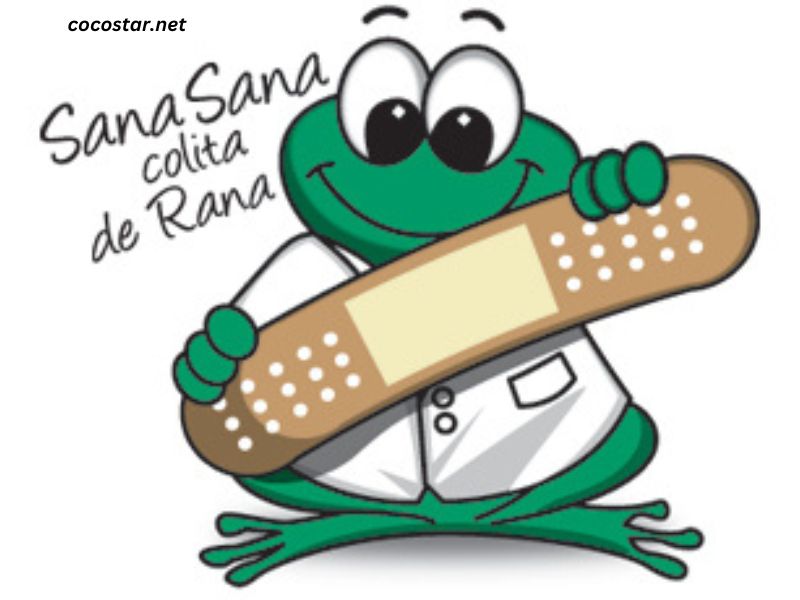The phrase “Sana sana colita de rana” is one of the most iconic and endearing sayings in the Spanish-speaking world, particularly in Latin America. It is a part of the cultural fabric of many childhoods, passed down from generation to generation. Whether whispered by parents, grandparents, or caretakers, this rhyme is usually accompanied by a gentle pat on the skin or a soothing gesture, and it carries a sense of warmth, healing, and comfort.
In this article, we will dive into the origins, meaning, and cultural significance of the expression “Sana sana colita de rana.” From its traditional use to its place in contemporary culture, this saying encapsulates the power of words and healing gestures in nurturing young minds and bodies.
The Meaning and Origins of “Sana Sana Colita de Rana”
At its core, “Sana sana colita de rana” is a playful rhyme that has been used to comfort children, especially when they experience small injuries, scrapes, or emotional distress. Translated to English, it means something like “Heal, heal, little tail of a frog.” While the literal meaning may sound unusual, the power of the phrase lies not in its literal translation but in its soothing, ritualistic nature.
In Spanish, “sana” is the imperative form of the verb “sanar,” which means “to heal.” So, when a parent or caregiver says “sana sana,” they are essentially urging the child to heal or feel better. The second part of the phrase, “colita de rana,” can be translated as “little tail of a frog.” In many cases, the specific imagery of a frog’s tail is not crucial—it’s simply part of the rhyme, adding rhythm and charm to the phrase. It’s worth noting that the “frog tail” element doesn’t necessarily have a deep symbolic meaning. It’s more about the rhythm and the connection between words in the rhyme.
The origin of this saying can be traced to the oral traditions of Latin America, where it was likely passed down as part of local folklore or traditional healing practices. The rhyme has become synonymous with the idea of nurturing and healing, even when there is no major injury. The phrase has been used for generations to reassure children that they will be okay after a minor injury or moment of sadness. The gesture that often accompanies the rhyme—a gentle pat on the hurt area—reinforces the idea that the pain is temporary and will be soothed away.
The Healing Power of Rituals and Rhymes
Saying “Sana sana colita de rana” is more than just a simple phrase; it is part of a larger ritual that can have a profound psychological and emotional effect on children. Rhymes and chants have been used for centuries as a means of healing, calming, and reassuring people, especially young ones, in various cultures. The rhythmic repetition of words, the melodic intonation, and the accompanying gestures all work together to create a sense of security and comfort.
From a psychological perspective, rituals like “Sana sana colita de rana” provide children with a sense of control and predictability during moments of distress. When a child falls and scrapes their knee, the world can feel uncertain and scary. However, the familiar words of this rhyme, delivered with love and care, offer a sense of reassurance. The comforting ritual of saying the phrase and applying gentle touch can help activate the body’s relaxation response, reducing stress and anxiety. It provides emotional healing, which is just as important as physical healing for children.
Additionally, the rhythm and repetition of the rhyme can serve as a form of distraction. For children experiencing pain, focusing on a familiar phrase can draw attention away from their discomfort, allowing their mind to focus on something positive instead. The act of reciting the rhyme also fosters a bond between the caregiver and the child, reinforcing trust and emotional connection.
“Sana Sana Colita de Rana” in Popular Culture
The influence of “Sana sana colita de rana” extends far beyond the home and traditional healing practices. Over time, this beloved rhyme has become a cultural touchstone in many Spanish-speaking countries, appearing in literature, music, television, and even memes. Its widespread popularity is a testament to its enduring charm and nostalgic appeal.
In many Latin American families, the phrase has become a part of the cultural lexicon, and it is often used in a playful or lighthearted context, even beyond the traditional use for healing. For example, some parents may recite it when their child is upset or frustrated, not just when they are physically hurt. In this context, it becomes a general expression of comfort and emotional support.
In addition to its use in everyday life, “Sana sana colita de rana” has also made appearances in various works of art. For instance, it has been referenced in children’s books and educational shows, further embedding it in popular culture. The rhyme is often used as a teaching tool to introduce children to rhythm, language, and positive emotional reinforcement.
Moreover, the rhyme has found its way into modern digital culture, particularly in the form of memes and social media trends. Given the meme-ification of many cultural sayings, “Sana sana colita de rana” has also taken on humorous, playful, and sometimes irreverent forms in online communities. Whether it’s used to lighten the mood in response to everyday frustrations or as a playful caption for photos, the phrase continues to resonate with people of all ages, reinforcing the idea that healing and comfort can come in many forms.
The Role of Caregivers in Healing: More Than Just Words
The impact of “Sana sana colita de rana” goes beyond the phrase itself; it highlights the importance of caregivers and their role in comforting children. Whether parents, grandparents, or other family members, caregivers play a crucial role in shaping a child’s emotional well-being and resilience. By engaging in rituals like this one, caregivers provide not only physical care but also emotional security.
For children, feeling loved and cared for during moments of distress is essential for their development. Comforting gestures, such as a hug or a soothing word, create a sense of safety and emotional stability. When caregivers repeat comforting phrases like “Sana sana colita de rana,” they convey to children that they are not alone in their pain. This sense of connection is especially important in helping children build emotional intelligence and resilience, teaching them that while pain is a part of life, it is manageable with the right support.
Additionally, caregivers who engage in these types of rituals are also teaching children how to respond to others’ pain and discomfort. They are modeling empathy and compassion, demonstrating that when someone is hurt or upset, the appropriate response is to offer comfort and support. In this way, the phrase serves not only as a tool for healing but also as a means of teaching children the value of kindness and care.
Contemporary Adaptations and Variations of the Phrase
While “Sana sana colita de rana” remains a widely recognized and beloved phrase, it has also evolved over time. In some regions or families, the rhyme has been adapted or expanded to include additional verses or variations. For example, some versions add lines like “Si no sanas hoy, sanarás mañana” (If you don’t heal today, you’ll heal tomorrow), reinforcing the idea that healing is inevitable and that time plays a role in recovery.
In some instances, the rhyme has taken on a more humorous or exaggerated tone. It has become common to hear playful adaptations such as “Sana sana colita de rana, que el dolor se va con la mañana” (Heal, heal, little frog’s tail, the pain will go away with the morning). These variations add a sense of whimsy and creativity to the original rhyme, keeping it fresh and fun for both children and adults alike.
Conclusion
The phrase “Sana sana colita de rana” is much more than a mere rhyme; it is a cultural artifact that represents love, care, and emotional healing. It has been passed down through generations, becoming a cornerstone of childhood experiences for millions of children in Spanish-speaking countries. The simple act of reciting the rhyme and offering comfort provides both physical and emotional healing, reinforcing the bond between caregivers and children.
In today’s world, the phrase continues to resonate, not just as a nostalgic relic of childhood but as a symbol of hope, care, and the power of words. Whether through its traditional use or its adaptation in modern memes and popular culture, “Sana sana colita de rana” remains a cherished reminder of the comfort and healing that can be found in simple, loving gestures.



